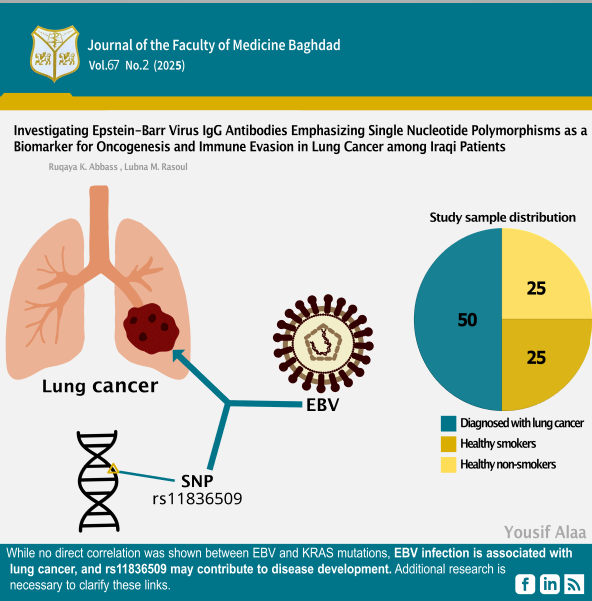Investigating Epstein-Barr Virus IgG Antibodies as a Biomarker for Oncogenesis and Immune Evasion in Lung Cancer among Iraqi Patients
DOI:
https://doi.org/10.32007/jfacmedbaghdad3057Keywords:
Epstein-Barr virus, Kirsten rat sarcoma virus, Lung cancer, Mutation, PolymorphismAbstract
Background: Lung cancer is the predominant cause of cancer-related mortality globally, accounting for 18.4% of all cancer fatalities, leading to significant economic loss and societal hardship. EBV was identified in 1964 as the premiere human oncogenic virus; it currently contributes to over 200,000 cancer cases annually and around 1.8% of all cancer-related deaths globally. The KRAS gene belongs to the family of rat sarcoma viral oncogenes (RAS), it was identified in lung cancer located on the short arm of chromosome 12 (12p11.1–12p12.1) in 1982.
Objectives: The study aims to analyze the complex molecular interactions among Epstein-Barr virus (EBV) IgG seropositivity, KRAS mutation-induced immunogenicity, and the genetic polymorphism rs121913238, emphasizing their combined effects on driving oncogenic signaling pathways, evading immune surveillance, and altering the tumor microenvironment to promote lung cancer initiation, progression, and phenotypic diversity.
Methods: A total number of 100 serum and whole blood samples were collected. Immunological assay procedure (ELISA) was conducted to measure the concentration of Anti-EBV IgG followed by two steps of molecular analysis: conventional PCR and gene polymorphism by Sanger sequencing technique to detect the targeted SNP in 30 samples
Results: The results indicated that EBV IgG levels were markedly higher in patients than in controls (P = 0.0003). The data indicate a possible role of EBV in lung cancer, necessitating additional investigation into its contribution to disease etiology.
The targeted SNP was not detected in either of the samples in the selected region, another SNP (rs11836509) was detected in 8 samples (6 patients and 2 controls). Conclusion: The viral infection showed no significant relation to the KRAS mutation, but it has a relation with the disease, the (rs11836509) correlates with lung carcinoma.
Received: Jan. 2025
Revised: April 2025
Accepted: May 2025
Published Online: May 2025
Published: July 2025
References
1. Rasoul LM. The Anti-cancer Impact of Genetically Engineered Newcastle Disease Virus Expressing GFP Gene Against U87-MG Cell Line. Iraqi Journal of Science. 2023;6204–14. https://doi.org/10.24996/ijs.2023.64.12.10
2. Bray F, Ferlay J, Soerjomataram I, Siegel RL, Torre LA, Jemal A. Global cancer statistics 2018: GLOBOCAN estimates of incidence and mortality worldwide for 36 cancers in 185 countries. CA Cancer J Clin. 2018 Nov;68(6):394–424. https://doi.org/10.3322/caac.21492
3. Al-Khateeb Z, Mahdi L. Prevalence of Lung Cancer in Al Najaf Governorate Registered in Middle Euphrates Oncology Center during 2019 and 2020. J Fac Med Baghdad. 2022 Apr 24;64(1):22–30. https://doi.org/10.32007/jfacmedbagdad.6411887
4. Edge SB, Compton CC. The American Joint Committee on Cancer: the 7th Edition of the AJCC Cancer Staging Manual and the Future of TNM. Ann Surg Oncol. 2010 Jun 24;17(6):1471–4. https://doi.org/10.1245/s10434-010-0985-4
5. Pikor LA, Ramnarine VR, Lam S, Lam WL. Genetic alterations defining NSCLC subtypes and their therapeutic implications. Lung Cancer. 2013 Nov;82(2):179–89. https://doi.org/10.1016/j.lungcan.2013.07.025
6. Wong SK, Iams WT. Front Line Applications and Future Directions of Immunotherapy in Small-Cell Lung Cancer. Cancers (Basel). 2021 Jan 29;13(3):506. https://doi.org/10.3390/cancers13030506
7. Sung H, Ferlay J, Siegel RL, et al. Global Cancer Statistics 2020: GLOBOCAN Estimates of Incidence and Mortality Worldwide for 36 Cancers in 185 Countries. CA Cancer J Clin. 2021 May 4;71(3):209–49. https://doi.org/10.3322/caac.21660
8. Brody H. Lung cancer. Nature. 2020 Nov 19;587(7834):S7–S7. https://doi.org/10.1038/d41586-020-03152-0
9. Ferlay J, Colombet M, Soerjomataram I, et al. Estimating the global cancer incidence and mortality in 2018: GLOBOCAN sources and methods. Int J Cancer. 2019 Apr 15;144(8):1941–53. https://doi.org/10.1002/ijc.31937
10. Rasoul LM, He J, Khoso MH, Li D. Use of viral vector to deliver IL-15 for cancer therapy: An overview. 2017; http://nopr.niscpr.res.in/handle/123456789/43110
11. Nanbo A, Noda T, Ohba Y. Epstein–Barr Virus Acquires Its Final Envelope on Intracellular Compartments With Golgi Markers. Front Microbiol. 2018 Mar 16;9. https://doi.org/10.3389/fmicb.2018.00454
12. Shannon-Lowe C, Rickinson A. The Global Landscape of EBV-Associated Tumors. Front Oncol. 2019 Aug 6;9. https://doi.org/10.3389/fonc.2019.00713
13. Rickinson EAB. Epstein-Barr virus. [Internet]. 2007 [cited 2023 Nov 8]. p. 2655. Available from: https://cir.nii.ac.jp/crid/1370565169358634270.bib?lang=en
14. Nsaif MM, Rasoul LM. Detection of EBV BNRF 1 Gene in Iraqi Schizophrenia Patients by Molecular Methods: doi. org/10.26538/tjnpr/v5i6. 4. Tropical Journal of Natural Product Research (TJNPR). 2021;5(6):1010–3. https://doi.org/10.26538/tjnpr/v5i6.4
15. Tugizov SM, Herrera R, Palefsky JM. Epstein-Barr Virus Transcytosis through Polarized Oral Epithelial Cells. J Virol. 2013 Jul 15;87(14):8179–94. https://doi.org/10.1128/jvi.00443-13
16. Barbacid M. ras GENES. Annu Rev Biochem. 1987 Jun;56(1):779–827. https://doi.org/10.1146/annurev.bi.56.070187.004023
17. McBride OW, Swan DC, Tronick SR, Gol R, Klimanis D, Moore DE, et al. Regional chromosomal localization of N-ras, K-ras-1, K-ras-2 and myb oncogenes in human cells. Nucleic Acids Res. 1983;11(23):8221–36. https://doi.org/10.1093/nar/11.23.8221
18. Moore AR, Rosenberg SC, McCormick F, Malek S. Author Correction: RAS-targeted therapies: is the undruggable drugged? Nat Rev Drug Discov. 2020 Dec 20;19(12):902–902. https://doi.org/10.1038/s41573-020-0089-1
19. Wood K, Hensing T, Malik R, Salgia R. Prognostic and Predictive Value in KRAS in Non–Small-Cell Lung Cancer. JAMA Oncol. 2016 Jun 1;2(6):805. https://doi.org/10.1001/jamaoncol.2016.0405
20. Pagano M, Gauvreau K, Mattie H. Principles of Biostatistics. Boca Raton: Chapman and Hall/CRC; 2022. https://doi.org/10.1201/9780429340512
21. Kohno T, Kunitoh H, Suzuki K, Yamamoto S, Kuchiba A, Matsuno Y, et al. Association of KRAS polymorphisms with risk for lung adenocarcinoma accompanied by atypical adenomatous hyperplasias. Carcinogenesis. 2008 May;29(5):957–63. https://doi.org/10.1093/carcin/bgn048
22. Antontseva E V, Matveeva MY, Bondar NP, Kashina E V, Leberfarb EY, Bryzgalov LO, et al. Regulatory single nucleotide polymorphisms at the beginning of intron 2 of the human KRAS gene. J Biosci. 2015;40:873–83. https://doi.org/10.1007/s12038-015-9567-8
23. Farrell PJ. Epstein–Barr Virus and Cancer. Annual Review of Pathology: Mechanisms of Disease. 2019 Jan 24;14(1):29–53. https://doi.org/10.1146/annurev-pathmechdis-012418-013023
24. Tan H, Gong Y, Liu Y, Long J, Luo Q, Faleti OD, et al. Advancing therapeutic strategies for Epstein-Barr virus-associated malignancies through lytic reactivation. Biomedicine & Pharmacotherapy. 2023 Aug;164:114916. https://doi.org/10.1016/j.biopha.2023.114916

Downloads
Published
Issue
Section
Categories
License
Copyright (c) 2025 Ruqaya K. Abbass, Lubna M. Rasoul

This work is licensed under a Creative Commons Attribution 4.0 International License.










 Creative Commons Attribution 4.0 International license..
Creative Commons Attribution 4.0 International license..


